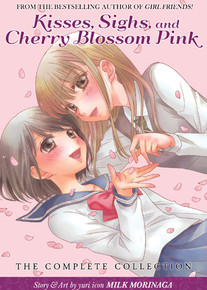Review
by Rebecca Silverman,Kisses, Sighs, and Cherry Blossoms Pink
GN - The Complete Collection
| Synopsis: |  |
||
Hitomi and Nana have been friends forever, but one day Hitomi surprises Nana by kissing her. Uncertain what to make of this new development, Nana brushes it off and then Hitomi, assuming her love is hopeless, enrolls in a different high school. Nana soon regrets her actions, but will a chance meeting with Hitomi enable her to start again? In the other stories in this collection, a ghost longs for her former love, a princely girl pursues her princess, and friends find themselves wondering if it is okay to be in love with another girl. |
|||
| Review: | |||
Originally published in two volumes, Milk Morinaga's Kisses, Sighs, and Cherry Blossom Pink is something of a confection. While true serious ground and deep emotions are tread upon across the stories, it is in general a much fluffier book than her series Girl Friends, previously published in English by Seven Seas. Despite that, there's still plenty for yuri fans to enjoy here; it simply doesn't feel like it has the cross-over potential that its English-language predecessor does. The main storyline here, which sporadically takes up most of the fourteen chapters in the thick volume, follows high school girls Nana and Hitomi, who definitely bear a passing physical resemblance to the heroines of Girl Friends. Nana and Hitomi have been close friends since elementary school, and Hitomi begs Nana to apply to Sakurakai, a girls' school with a cute sailor uniform, because she really wants to see Nana in it. Nana assumes that Hitomi will also apply there, but receives a rude shock when Hitomi tells her that she's going somewhere else. Thinking back, Nana is able to find the root of the problem – in the ninth grade (the last year of middle school in Japan), Hitomi kissed her. Uncertain how to respond, Nana laughed it off, but she now realizes that not only did she deeply wound her friend, but that Nana herself might also harbor romantic feelings for Hitomi. The two get back together fairly quickly, and the rest of their chapters are devoted to trying to simultaneously hide their relationship from others and to making it work. In a lot of ways, the troubles that Hitomi and Nana have letting the world know (or not) that they are more than friends is the most interesting part of the volume, and an issue that the other couples in the book don't really deal with. Several times over the course of the book, someone remarks that same-sex couples are “gross” or “unnatural,” and Hitomi really takes that to heart. She feels that she needs to be the “man” in the relationship, protecting Nana from a world that would rather hurt them than see them be together. In a great scene in their last chapter, Nana calls her on that, pointing out that neither needs to be “the man” because they are both women, which allows their relationship to operate outside of gender normed restrictions. While Morinaga doesn't do much with that other than make the statement, its simple inclusion makes an impact. It is too bad that the Hitomi and Nana chapters aren't grouped more consecutively, with the unrelated short stories placed either ahead of or behind them. While there is some effort made at linking them – many of the tales take place at Sakurakai, Nana's school, and feature her friends or Hitomi's – they mostly serve to interrupt the girls' narrative. This, it should be noted, is no fault of Seven Seas, as Morinaga notes in the back that these stories were written over a long period of time and were published in Japan in this order. She also laments that her art style has not changed at all over time, and for the most part, this is true – before reading her note, it is very difficult to tell that this book wasn't written in one shot. Going back, one can see the small changes, particularly in terms of eyes and comfort with body language, but in all honesty her unchanging style really helps with the book. There is no jarring effect as her art abruptly refines itself, which sometimes happens when an author's older works are published alongside her newer efforts. Artistically, the book reads very smoothly, which is important when the main story is separated by shorts. Kisses, Sighs, and Cherry Blossom Pink can get a little too pretty at times in its artwork (you've never seen such lovely soft art for sex scenes) and is a bit broken up as far as the best and longest story is concerned, but it is still a book yuri fans or the yuri-curious should check out. Morinaga explores some of the social worries of being gay and coming out while also covering very sweet romances and bittersweet one-sided loves, and there's a lot to enjoy in this omnibus edition. It isn't a good as Girl Friends, but it is still very readable and enjoyable. |
|
The views and opinions expressed in this article are solely those of the author(s) and do not necessarily represent the views of Anime News Network, its employees, owners, or sponsors.
|
| Grade: | |||
Overall : B
Story : B
Art : B-
+ Hitomi and Nana story is quite good and covers a lot of emotional ground. The last two short stories are also strong and Morinaga's relationships exist in the real world rather than in a yuri fantasy land. Girls have real relationships with their parents. |
|||
| discuss this in the forum (6 posts) | | |||
| Production Info: | ||
|
Full encyclopedia details about Release information about |
||